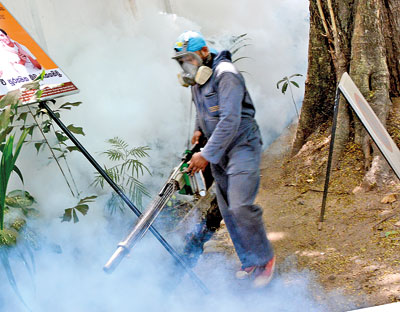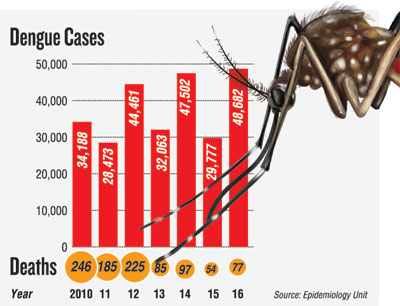News
Battle against dengue continues as the disease rages

Fogging in progress
Despite numerous anti-dengue drives the disease continues to take its toll across the country with more than 48,000 cases reported with 77 deaths, so far for this year, the Health Ministry said.
The number of dengue cases were 20,000 more than last year’s figures.
Health officials warn that it may reach epidemic proportions in the coming days, claiming more lives.
More than 77, 728 premises have been inspected within the last three days with 60,490 premises in the Western Province alone. Mosquito larvae had been detected in 639 of the premises. More than 1000 households were issued with warning notices and legal action would be taken against 402 of them, a Health Ministry official said.
The official said the total number of cases last year was 29,000 with 54 deaths while in 2014 the number topped 47,500 with the death toll at 99.
According to Health authorities, there are two peak seasons for dengue: First from May to end July, the second from November to January of the following year.
Health, environment, education, public administration, local government, transport, housing and defence ministries should work together, as most of the institutions and places with dengue breeding spots come under these ministries, the official said.
The Health Ministry was finding it hard to single out high-risk areas with dengue cropping up constantly in many districts. All four dengue serotypes were present in the country, making the disease widespread.
Colombo (14,510), Gampaha (6,042), Kalutara (3,119), Galle (2,436) Jaffna (2,087) Puttalam (979), Batticaloa (493), Ampara (231), Ratnapura (2,832), Kurunegala (2,313).
Dr. Ananda Wijesuriya at the Infectious Diseases Hospital (IDH) said that, 12 students who were sitting for the O/L examination, that ended yesterday, were being treated for dengue. Steps were taken to set up an examination centre for them at the Hospital while the doctors were keeping a close watch on them.
Colombo Municipal Council (CMC) Chief Health Officer Dr. Ruwan Wijeyamuni said that, the main breeding spots in the Colombo District were water receptacles varying from yogurt cups to rain gutters, air conditioning and refrigerator trays while in the Gampaha District they were mainly natural breeding spots such as water retention plants and trees. 
He said mosquito larvae was found in government institutions, schools, construction sites, hostels and even hospitals.
The Western Province is the most affected by dengue with most of the deaths and cases being reported from the districts of Colombo and Gampaha.
Mosquito control methods such as fogging, getting rid of containers and spraying had helped in the fight, the official added. “We took legal action where it was needed and it must be added that the community helped us tremendously in the process,”Dr. Wijeyamuni said
The annual social cost incurred due to dengue is Rs. 7 billion. This includes man-hours spent in hospitals and costs incurred in the treatment of dengue patients, mosquito coils, air-condition machines to prevent mosquitoes, import of Bti and other larvicide, spraying, fogging and fumigating equipment, awareness programmes and recruiting labourers for dengue control work.
Ten years ago dengue cases began in Colombo West and Colombo East and later shifted to Colombo North from these areas, a senior official of the National Dengue Control Unit (NDCU) Dr. Preshila Samaraweera said. In 2014 and 2015 the outbreaks started first in Colombo North and shifted to Colombo West and East, he added.
“This year the pattern has changed and it is back to what we observed ten years ago. We have changed our strategy accordingly. We have an effective cadre of workers and I have reorganised the pest control unit that was established two months ago,” she said.
A majority of mosquito larvae was detected in household environments followed by schools.
A health official said that regular cleaning should take place and schools should follow a zero policy on discarding of containers such as empty yogurt and ice-cream cups and polythene “sili sili” bags.
“Fumigating and fogging are temporary solutions. Schools should get labourers to clean the gutters and tree holes that are the main breeding spots in schools,” he said.
Additional Provincial Director of Health Services in the north, Dr. T. Saythyamoorthy said the national hospitals in the city were seeing a huge rush of patients. The disease will show a peak till January and then it will decline.
He also advised people not to rely on “herbal cures” as there was no scientific proof that they help fight the disease. Those who advocate these remedies say giloy (?) and papaya leaves and aloe vera have been used on dengue patients to increase the platelet count.
Ratnapura Provincial Hospital Director Dr. Sampath Ranaweera said hospital staff was struggling to keep pace with the influx of patients.
“My colleagues and staff who have been here have been working day and night and we have set a separate fever clinic which is in operation 24/7. There are almost 200 to 300 patients,” he said.
A spokesman for Kalutara Hospital said another reason for the rise in the figures, may have been the fact that case-based fogging had not been carried out to a 100 percent, because of the high number of cases
Usually when authorities are informed of dengue in an area fogging is carried out within three days,but when the cases were high this was a difficult task, because of the shortage of staff. They even had to bring in staff from the North and South of the country to carry out the fogging.

